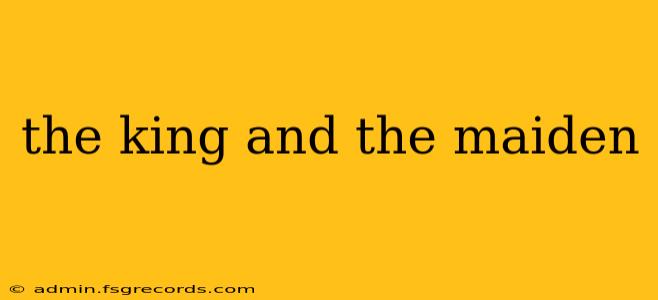The enduring appeal of the "King and the Maiden" archetype transcends cultures and centuries. It speaks to fundamental human desires: love, power, duty, and the often-conflicting nature of these powerful forces. While specific narratives vary widely, the core themes remain remarkably consistent, offering fertile ground for exploring complex emotional landscapes and societal structures. This exploration delves into the recurring motifs, symbolic interpretations, and enduring legacy of this classic tale.
The Power Dynamics: Kingship and Maidenhood
The inherent power imbalance between a king and a maiden is a crucial element. The king, representing authority, wealth, and often, a rigid social order, holds significant sway over the maiden's life. This asymmetry immediately introduces conflict potential. The maiden, frequently depicted as possessing beauty, innocence, or exceptional talent, finds herself navigating a world where her choices are often limited by the king's power and the expectations of his court. This dynamic sets the stage for narratives exploring themes of:
- Consent and Agency: Does the maiden willingly participate in the relationship, or is she subject to the king's will? Many variations explore this crucial aspect, highlighting the evolving understanding of female autonomy throughout history.
- Social Expectations: The maiden's role is often defined by her position within the kingdom. She might be a pawn in political maneuvering, a symbol of national unity, or a source of hope for the people. Her actions (or inaction) can have far-reaching consequences.
- Love vs. Duty: The king may genuinely love the maiden, or he might use her for political gain. Similarly, the maiden's feelings may range from genuine affection to reluctant acceptance or even deep resentment. This internal conflict drives much of the narrative's emotional weight.
Variations on a Theme: From Fairytales to Epic Poems
The "King and the Maiden" motif manifests in countless forms:
- Fairytales: Stories like "Sleeping Beauty" or "Rapunzel" often present idealized versions, with the king as a rescuer or a benevolent figure. However, closer examination often reveals underlying power dynamics and questionable choices.
- Epic Poems and Legends: In more complex narratives, the king might be a flawed or tyrannical character, and the maiden's role becomes more pivotal in challenging his authority or bringing about change. Consider the numerous stories featuring brave princesses who defy their royal fathers or cunningly manipulate powerful kings.
- Modern Interpretations: Contemporary literature and film adapt the archetype to modern contexts. The power imbalance might be subtly presented, reflecting contemporary social inequalities or the complexities of romantic relationships.
Symbolism and Interpretation
The symbols within these narratives are rich and multi-layered:
- The King's Crown: Represents power, authority, and the burden of responsibility.
- The Maiden's Dress: Can symbolize innocence, purity, or societal expectations.
- The Castle or Palace: Represents the structured world the maiden must navigate.
- The Forest or Wilderness: Can symbolize freedom, danger, or escape from societal constraints.
The Enduring Legacy
The "King and the Maiden" archetype continues to resonate because it taps into our fascination with power, love, and the human condition. It allows us to explore fundamental questions about relationships, social structures, and the choices we make in the face of conflicting desires. By analyzing different iterations of this enduring motif, we gain insights into the evolving perspectives on gender roles, social justice, and the complex interplay between personal desires and societal expectations. It remains a powerful tool for storytelling, ensuring its continued relevance across generations.

